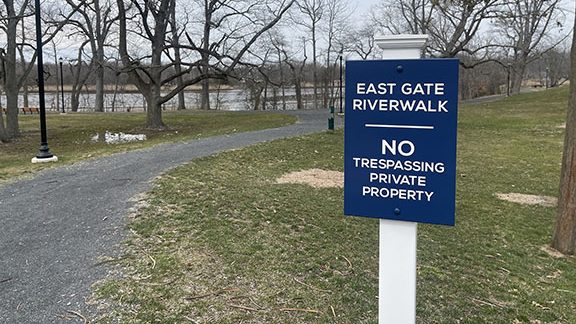
By Laura D.C. Kolnoski
FORT MOMMOUTH – While scouting locations for commemorative markers along Fort Monmouth’s new Riverwalk promenade on Parkers Creek, members of Oceanport’s Historical Committee were met with “No Trespassing” signs in the East Gate development. Subsequently, Fort Monmouth Economic Revitalization Authority (FMERA) officials launched an inquiry into their origin.
“Riverwalk is supposed to be public, but some residents think they can claim it as private property,” historical committee member Rosanne Letson told the FMERA board during the agency’s regular monthly meeting March 15. “Did someone tell them that?”
That is the question officials seek to answer.
According to Sarah Giberson, FMERA senior marketing and real estate development officer, the intention was to have a publicly accessible walking path beginning near the “400 Area”/ Allison Hall development near Oceanport Avenue, adjacent to the Little Silver boundary, extending from one side of the fort to the other, with no portions privately owned. Developers are each required by contract to construct their portion of the Riverwalk.
In addition to residential developments, commercial operations coming along the interconnected waterfront promenade include an indoor/outdoor restaurant, stores, offices and a potential boutique hotel.
The East Gate residences were the first to be occupied on Fort Monmouth after the RPM Development Group of Montclair purchased and renovated former Officers Housing in the Oceanport section.
“RPM sold the entirety of the property to an HOA (homeowners association) for the long-term management of the site, as the development is within the Historic District, and there are specific ‘rules’ tied to the homes and any improvements to them,” Giberson said. “Each home is individually owned, but the HOA retains ownership of the common areas.” The signs were also spotted by a member of the FMERA team, she added.
“Once sold to RPM and they sold to others, it’s unclear what the representation was,” said Kara Kopach, FMERA executive director, although she told Letson at the meeting, “We have a shared vision.”
“The walking trail was always anticipated to be open to the public,” Kopach said. “We are in a fact-finding situation right now, reviewing legal documents and working with Oceanport. We are trying to understand how we got here. We will call upon the HOA to ask what was represented to them.”
Oceanport is assisting with a review of approvals and meeting minutes.
“We don’t want to see the best of the fort lost,” Letson said, noting the historical committee is seeking a grant to fund the historical markers to commemorate highlights of the fort’s storied 100-year history. Members have undertaken a similar project at Old Wharf Park.
Housing Obligations Shifted From Netflix’s Mega Parcel
A target of 1,585 residences was established in Fort Monmouth’s master reuse plan devised over 10 years ago, spread throughout the fort’s 1,126 acres spanning portions of Eatontown, Oceanport and Tinton Falls, with 20 percent designated affordable housing. Much new fort housing has already been built or is under construction on the former U.S. Army base.
In creating the 292-plus-acre Mega Parcel now moving through the sales process between FMERA and Netflix, officials combined several parcels in Eatontown and Oceanport to increase the site’s marketability. Since Netflix intends to build an all-commercial production facility, remaining housing obligations originally assigned there will shift to other locations on the fort.
“The Mega Parcel Request for Offers to Purchase had the option to include housing, but it was not a requirement,” Giberson said. “FMERA reserved space for housing development at an alternate location in the event that the leading proposer on the Mega Parcel did not include housing.”
The obligations assigned to Eatontown’s sections of the Mega Parcel could potentially go to Parcels 7 and 8, currently a football field and open space. The exact municipal boundaries of Parcels 7 and 8 have not yet been established, Giberson said, adding Oceanport’s obligations have been identified in other fort tracts.
“Housing can and likely will be built in the future at the alternate location,” she said.
The article originally appeared in the March 23 – 29, 2023 print edition of The Two River Times.














